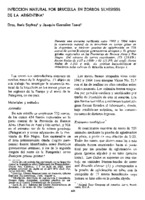Infección natural por brucella en zorros silvestres de la Argentina
Date
s.d.1967
Metadata
Show full item recordAbstract
The role of foxes and other wild animals in the spread of brucellosis is still a matter for discussion. Many wild vertebrate animals are susceptible of being infected either naturally or experimentally. Using serological and bacteriological methods, the authors studied the natural occurrence of brucellosis in wild foxes in Argentina. Of the 728 animals examined (410 Dusicyon gymnocercus antiquus and 318 D. griseus griseus captured in the Provinces of Buenos Aires and Río Negro), 13.9 per cent of the D. gymnocercus and 7.9 per cent of the D. griseus had agglutination titers of 1:100 or more. The number of males and females was approximately equal and there was no significant difference in the rate of reactions by sex. This finding is in contrast to observations made in Europe, that female foxes (Vulpes vulpes) are more likely to contract brucellosis than males. In several ranches where the agglutination test was peformed in cattle as well, the percentage of foxes reacting (at 1:100 or more) was higher than that of cattle. Thirty-four individual specimens of D. gymnocercus were examined bacteriologically, as were 31 pools of the organs of 77 foxes of the same species: Burecella cultures were obtained from five pools and three from individual foxes. Four of the five bacteriologically positive pools contained organs of one or two individuals with a titer of 1:100 or higher. The fifth positive Artículo publicado en inglés en el Bull. WHO 34(6):919-23, 1966
Translated title
Natural brucella infection in Argentine wild foxes
Collections
Related items
Showing items related by title, author, creator and subject.
-
Unknown author (s.d.)This Center was organized to furnish basic training to those working on the control of venereal diseases, especially for the Ministry of Health and Welfare, of Mexico though it is open to workers from other governmental ...
-
Pawluk, Mariela Soledad; Campaña, Hebe; Rittler, Monica; Poletta, Fernando Adrián; Cosentino, Viviana R.; Gili, Juan Antonio; Gimenez, Lucas Gabriel; López Camelo, Jorge Santiago (2017-10)Objective. The aim of this study was to analyze the effects of individual low socioeconomic status (SES) and deprived geographical area (GA) on the occurrence of isolated cleft lip with or without cleft palate (CL±P) in ...
-
Laniado-Laborín, Rafael (2017)In 2014, there were 480 000 new cases of multidrug-resistant tuberculosis (MDR-TB) around the world, but only 25% of them were diagnosed and reported. Drug resistance in TB is necessarily a laboratory diagnosis. An urgent ...




